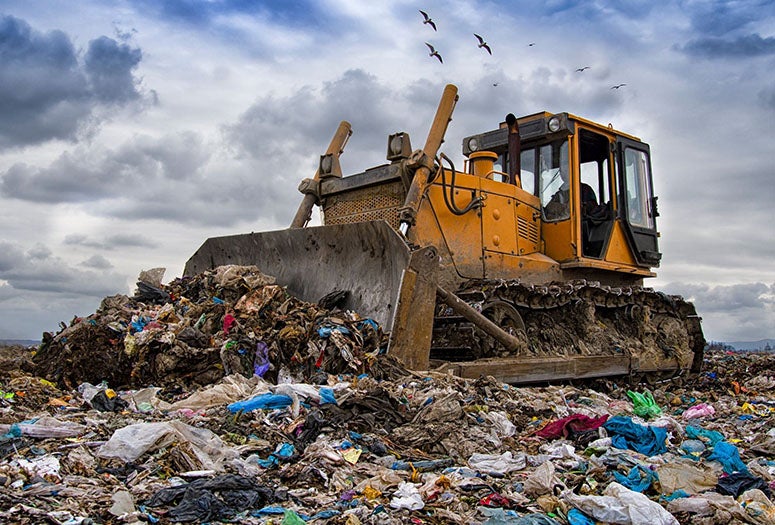HOUSTON – (Aug. 4, 2021) – Both sustainability practices and a circular economy can help maximize the world’s resources, but the ideas are not interchangeable, according to a new brief from Rice University's Baker Institute for Public Policy.
A circular economy (CE) aims to remedy “unsustainable production, consumption and waste generation” by encouraging innovations that reduce waste and increase reuse, according to Rachel Meidl, Fellow in Energy and Environment at the Baker Institute. Meidl is available to discuss the topic with the news media.
“The ultimate objective is to transition from today's linear arrangement of ‘take-make-use-dispose’ to a regenerative circular system where the societal value of products, materials and resources is maximized over time,” she wrote.
Yet, the term “sustainability”— a misconstrued word that is often used synonymously with the circular economy — is interwoven into conversations about decarbonization and the transition to renewable energy, according to Meidl.
“Although there is a relationship between sustainability and a CE, these two concepts are vastly distinct,” she wrote.
Sustainability is a macro-level approach that considers the wide array of environmental, social and economic factors associated with a process, product or technology and assesses how they interact, according to the brief.
A CE provides the economic system with an alternative model — one designed to be regenerative and build resilience against future disruptions like pandemics or extreme weather. From sourcing to manufacturing to distribution to use and recycling, a circular economy ensures each part is designed for resource efficiency and durability. The ability to optimize resources would help achieve a healthier balance between the economy, the environment and society, Meidl argues.
“Sustainability, mediated by innovation, can enable a CE, and a CE can be a means or stepping stone toward the alignment between the three dimensions of sustainability (the economic, social and environmental),” she wrote.
However, circularity in and of itself does not guarantee positive social, economic and environmental performance — or sustainability — Meidl explains.
“Just as sustainability can be misrepresented, a CE is accompanied by vast versatility, wide-ranging scope and applications, definitional ambiguities, disparities and conceptual uncertainties,” she wrote. “This makes it challenging to compare with its linear counterparts and can result in a partial, convoluted or erroneous depiction of circularity — especially since the boundaries and application of a CE can be employed at the product or process level, within an organization and at the local, regional, national or global scale for both public and private sectors.”
Ensuring a successful transition to a sustainable, circular economy requires not only a common understanding and approach to circularity, but also the ability to consistently measure and report at the micro and macro levels, Meidl argues.
“Sustainability of CE strategies should be uniformly and consistently measured against their linear counterparts to identify and avoid actions that are favorable to and increase circularity yet lead to unintended externalities that shift the sustainability profile,” she wrote.
Analysis of planned and standardized methods — such as properly scoped life-cycle assessments, materials flow analysis and systems dynamics — can provide a holistic view for better evaluation the environmental and societal impacts from producing goods or services.
“It can also help clarify the relationship and potential conflicts between sustainability, a CE and waste management principles and provides important tools to identify risks, understand trade-offs and avoid unintended externalities,” she wrote.
“The preparation and conversations should start now about how we can optimize human, capital and natural resources to create a circular and sustainable economy,” Meidl continued. “When assessed through the lens of systems sustainability, circularity can uncover new investment opportunities, create novel business models, encourage innovative products and technologies, foster supply chain collaboration and build an economy that is far more resilient against future global disruptions.”
To schedule an interview with Meidl, or for more information, contact Avery Franklin, media relations specialist at Rice, at averyrf@rice.edu or 713-348-6327.
-30-
Related materials:
Study: https://www.bakerinstitute.org/media/files/files/fb002fe9/bi-brief-072921-ces-circulareconomy.pdf.
Meidl bio: https://www.bakerinstitute.org/experts/rachel-a-meidl/.
Follow the Baker Institute via Twitter @BakerInstitute.
Follow Rice News and Media Relations via Twitter @RiceUNews.
This news release can be found online at news.rice.edu.
Founded in 1993, Rice University’s Baker Institute ranks as the No. 1 university-affiliated think tank in the world and the No. 1 energy think tank in the world. As a premier nonpartisan think tank, the institute conducts research on domestic and foreign policy issues with the goal of bridging the gap between the theory and practice of public policy. The institute’s strong track record of achievement reflects the work of its endowed fellows, Rice University faculty scholars and staff, coupled with its outreach to the Rice student body through fellow-taught classes — including a public policy course — and student leadership and internship programs. Learn more about the institute at www.bakerinstitute.org or on the institute’s blog, http://blog.bakerinstitute.org.

